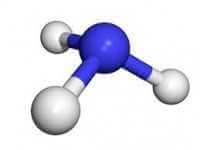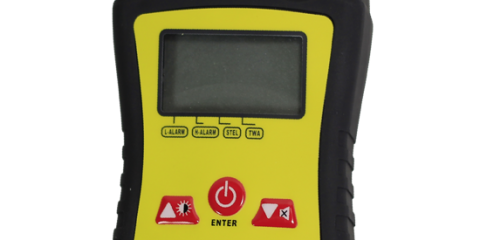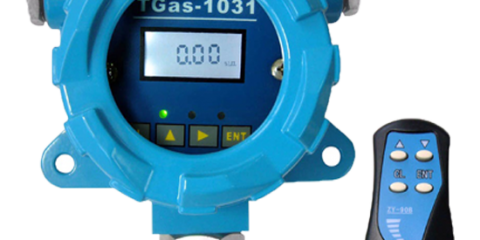 STEL: 35ppm
STEL: 35ppm
(Short Term exposure Limit – 15mins)
TWA: 25ppm
(Time Weighted Average – 8 hrs)
 Alarm Recomendations
Alarm Recomendations
Rising Latching Alarms For Line Safety Applications
First Alarm: Second Alarm: Third Alarm:
25ppm 35ppm optional
Ammonia is composed of Nitrogen and Hydrogen. It is a colourless gas with a characteristic pungent smell. Ammonia (NH3) is one of the most commonly produced industrial chemicals. NH3 is very toxic and also flammable with an LEL of 16%
Anhydrous Ammonia gas is lighter than air and will rise however in the presence of moisture (such as high relative humidity). The liquefied anhydrous ammonia gas forms vapours that are heavier than air. This can increase the risk of exposure from leaks to personnel, particularly in large NH3 refrigeration plant.
In the environment, NH3 is part of the nitrogen cycle and is produced in soil from bacterial processes. NH3 is also produced naturally from decomposition of organic matter, including plants, animals and animal wastes.
Physical properties of ammonia include:
At room temperature, ammonia is a colourless, highly irritating gas with a pungent odour.
In pure form, it is known as anhydrous ammonia and readily absorbs moisture.
NH3 is corrosive.
NH3 gas is easily compressed and forms a clear liquid under pressure.
NH3 is usually shipped as a compressed liquid in steel containers.
Containers of ammonia may explode when exposed to high heat.
As fewer and fewer CFCs and HCFCs are available for use as refrigerants ammonia has become popular as a replacement. Ammonia is a cost-effective, efficient alternative to CFCs and HCFCs that is also safe for the environment.
Frequently used commercially in large freezing and refrigeration plants is also called “anhydrous ammonia†because it contains almost no water (it is 99.98% pure).
As a refrigerant, Ammonia has many advantages over CFCs and HCFCs:
An ammonia-based refrigeration systems costs 10-20% less to build than one that uses CFCs because narrower-diameter piping can be used.
NH3 is a 3-10% more efficient refrigerant than CFCs, so an ammonia-based system requires
NH3 is safe for the environment, with an Ozone Depletion Potential (ODP) rating of 0 and a Global Warming Potential (GWP) rating of 0.
NH3 is substantially less expensive than CFCs or HCFCs
However:
NH3 is incompatible with copper, so it cannot be used in any system with copper pipes.
NH3 is toxic
NH3 is Flammable
Products related to Ammonia:





Warning: preg_replace(): Unknown modifier 'a' in /www/wwwroot/globeinstrument.com/wp-content/themes/theme/functions.php on line 147
https://shorturl.fm/dbZKy
Warning: preg_replace(): Unknown modifier 'a' in /www/wwwroot/globeinstrument.com/wp-content/themes/theme/functions.php on line 147
https://shorturl.fm/9DeIq
Warning: preg_replace(): Unknown modifier 'a' in /www/wwwroot/globeinstrument.com/wp-content/themes/theme/functions.php on line 147
https://shorturl.fm/8p8c4
Warning: preg_replace(): Unknown modifier 'a' in /www/wwwroot/globeinstrument.com/wp-content/themes/theme/functions.php on line 147
https://shorturl.fm/uD1Jv
Warning: preg_replace(): Unknown modifier 'a' in /www/wwwroot/globeinstrument.com/wp-content/themes/theme/functions.php on line 147
https://shorturl.fm/nhw8K
Warning: preg_replace(): Unknown modifier 'a' in /www/wwwroot/globeinstrument.com/wp-content/themes/theme/functions.php on line 147
https://shorturl.fm/0QgCG
Warning: preg_replace(): Unknown modifier 'a' in /www/wwwroot/globeinstrument.com/wp-content/themes/theme/functions.php on line 147
https://shorturl.fm/hUJK1
Warning: preg_replace(): Unknown modifier 'a' in /www/wwwroot/globeinstrument.com/wp-content/themes/theme/functions.php on line 147
https://shorturl.fm/K3G4k
Warning: preg_replace(): Unknown modifier 'a' in /www/wwwroot/globeinstrument.com/wp-content/themes/theme/functions.php on line 147
https://shorturl.fm/DHJZB
Warning: preg_replace(): Unknown modifier 'a' in /www/wwwroot/globeinstrument.com/wp-content/themes/theme/functions.php on line 147
https://shorturl.fm/DPJbw
Warning: preg_replace(): Unknown modifier 'a' in /www/wwwroot/globeinstrument.com/wp-content/themes/theme/functions.php on line 147
https://shorturl.fm/u0YM3
Warning: preg_replace(): Unknown modifier 'a' in /www/wwwroot/globeinstrument.com/wp-content/themes/theme/functions.php on line 147
https://shorturl.fm/qCu5t
Warning: preg_replace(): Unknown modifier 'a' in /www/wwwroot/globeinstrument.com/wp-content/themes/theme/functions.php on line 147
https://shorturl.fm/CwuW2
Warning: preg_replace(): Unknown modifier 'a' in /www/wwwroot/globeinstrument.com/wp-content/themes/theme/functions.php on line 147
https://shorturl.fm/WhEZc
Warning: preg_replace(): Unknown modifier 'a' in /www/wwwroot/globeinstrument.com/wp-content/themes/theme/functions.php on line 147
https://shorturl.fm/n2dRh
Warning: preg_replace(): Unknown modifier 'a' in /www/wwwroot/globeinstrument.com/wp-content/themes/theme/functions.php on line 147
https://shorturl.fm/nHjTn
Warning: preg_replace(): Unknown modifier 'a' in /www/wwwroot/globeinstrument.com/wp-content/themes/theme/functions.php on line 147
https://shorturl.fm/IqyCI
Warning: preg_replace(): Unknown modifier 'a' in /www/wwwroot/globeinstrument.com/wp-content/themes/theme/functions.php on line 147
https://shorturl.fm/3jjlZ
Warning: preg_replace(): Unknown modifier 'a' in /www/wwwroot/globeinstrument.com/wp-content/themes/theme/functions.php on line 147
https://shorturl.fm/lPx4L
Warning: preg_replace(): Unknown modifier 'a' in /www/wwwroot/globeinstrument.com/wp-content/themes/theme/functions.php on line 147
https://shorturl.fm/Hhhhu
Warning: preg_replace(): Unknown modifier 'a' in /www/wwwroot/globeinstrument.com/wp-content/themes/theme/functions.php on line 147
https://shorturl.fm/DGX0Y
Warning: preg_replace(): Unknown modifier 'a' in /www/wwwroot/globeinstrument.com/wp-content/themes/theme/functions.php on line 147
https://shorturl.fm/VQw3B
Warning: preg_replace(): Unknown modifier 'a' in /www/wwwroot/globeinstrument.com/wp-content/themes/theme/functions.php on line 147
https://shorturl.fm/mQ52I
Warning: preg_replace(): Unknown modifier 'a' in /www/wwwroot/globeinstrument.com/wp-content/themes/theme/functions.php on line 147
https://shorturl.fm/ToSsI
Warning: preg_replace(): Unknown modifier 'a' in /www/wwwroot/globeinstrument.com/wp-content/themes/theme/functions.php on line 147
https://shorturl.fm/w1YAW
Warning: preg_replace(): Unknown modifier 'a' in /www/wwwroot/globeinstrument.com/wp-content/themes/theme/functions.php on line 147
https://shorturl.fm/noNd2
Warning: preg_replace(): Unknown modifier 'a' in /www/wwwroot/globeinstrument.com/wp-content/themes/theme/functions.php on line 147
https://shorturl.fm/us2s6
Warning: preg_replace(): Unknown modifier 'a' in /www/wwwroot/globeinstrument.com/wp-content/themes/theme/functions.php on line 147
https://shorturl.fm/Yqq8k
Warning: preg_replace(): Unknown modifier 'a' in /www/wwwroot/globeinstrument.com/wp-content/themes/theme/functions.php on line 147
https://shorturl.fm/bp5Yx
Warning: preg_replace(): Unknown modifier 'a' in /www/wwwroot/globeinstrument.com/wp-content/themes/theme/functions.php on line 147
https://shorturl.fm/oBT4K
Warning: preg_replace(): Unknown modifier 'a' in /www/wwwroot/globeinstrument.com/wp-content/themes/theme/functions.php on line 147
https://shorturl.fm/44Ncd
Warning: preg_replace(): Unknown modifier 'a' in /www/wwwroot/globeinstrument.com/wp-content/themes/theme/functions.php on line 147
https://shorturl.fm/aYCea
Warning: preg_replace(): Unknown modifier 'a' in /www/wwwroot/globeinstrument.com/wp-content/themes/theme/functions.php on line 147
https://shorturl.fm/bUXBH
Warning: preg_replace(): Unknown modifier 'a' in /www/wwwroot/globeinstrument.com/wp-content/themes/theme/functions.php on line 147
https://shorturl.fm/reQLG
Warning: preg_replace(): Unknown modifier 'a' in /www/wwwroot/globeinstrument.com/wp-content/themes/theme/functions.php on line 147
https://shorturl.fm/BWEAT
Warning: preg_replace(): Unknown modifier 'a' in /www/wwwroot/globeinstrument.com/wp-content/themes/theme/functions.php on line 147
https://shorturl.fm/CbHxA
Warning: preg_replace(): Unknown modifier 'a' in /www/wwwroot/globeinstrument.com/wp-content/themes/theme/functions.php on line 147
https://shorturl.fm/ZYe1z
Warning: preg_replace(): Unknown modifier 'a' in /www/wwwroot/globeinstrument.com/wp-content/themes/theme/functions.php on line 147
https://shorturl.fm/Cb3ip
Warning: preg_replace(): Unknown modifier 'a' in /www/wwwroot/globeinstrument.com/wp-content/themes/theme/functions.php on line 147
https://shorturl.fm/lonND
Warning: preg_replace(): Unknown modifier 'a' in /www/wwwroot/globeinstrument.com/wp-content/themes/theme/functions.php on line 147
https://shorturl.fm/Ie5DU
Warning: preg_replace(): Unknown modifier 'a' in /www/wwwroot/globeinstrument.com/wp-content/themes/theme/functions.php on line 147
https://shorturl.fm/4mxGy
Warning: preg_replace(): Unknown modifier 'a' in /www/wwwroot/globeinstrument.com/wp-content/themes/theme/functions.php on line 147
https://shorturl.fm/BTGwu
Warning: preg_replace(): Unknown modifier 'a' in /www/wwwroot/globeinstrument.com/wp-content/themes/theme/functions.php on line 147
https://shorturl.fm/HnJwp
Warning: preg_replace(): Unknown modifier 'a' in /www/wwwroot/globeinstrument.com/wp-content/themes/theme/functions.php on line 147
https://shorturl.fm/gAxiT
Warning: preg_replace(): Unknown modifier 'a' in /www/wwwroot/globeinstrument.com/wp-content/themes/theme/functions.php on line 147
https://shorturl.fm/eEBbZ
Warning: preg_replace(): Unknown modifier 'a' in /www/wwwroot/globeinstrument.com/wp-content/themes/theme/functions.php on line 147
https://shorturl.fm/zqwfd
Warning: preg_replace(): Unknown modifier 'a' in /www/wwwroot/globeinstrument.com/wp-content/themes/theme/functions.php on line 147
https://shorturl.fm/jlzu0
Warning: preg_replace(): Unknown modifier 'a' in /www/wwwroot/globeinstrument.com/wp-content/themes/theme/functions.php on line 147
https://shorturl.fm/gUBvq
Warning: preg_replace(): Unknown modifier 'a' in /www/wwwroot/globeinstrument.com/wp-content/themes/theme/functions.php on line 147
https://shorturl.fm/ZIhB5
Warning: preg_replace(): Unknown modifier 'a' in /www/wwwroot/globeinstrument.com/wp-content/themes/theme/functions.php on line 147
https://shorturl.fm/l2fyt
Warning: preg_replace(): Unknown modifier 'a' in /www/wwwroot/globeinstrument.com/wp-content/themes/theme/functions.php on line 147
https://shorturl.fm/dEYSF
Warning: preg_replace(): Unknown modifier 'a' in /www/wwwroot/globeinstrument.com/wp-content/themes/theme/functions.php on line 147
https://shorturl.fm/ymAwJ
Warning: preg_replace(): Unknown modifier 'a' in /www/wwwroot/globeinstrument.com/wp-content/themes/theme/functions.php on line 147
https://shorturl.fm/FIt6L
Warning: preg_replace(): Unknown modifier 'a' in /www/wwwroot/globeinstrument.com/wp-content/themes/theme/functions.php on line 147
https://shorturl.fm/C3pcH
Warning: preg_replace(): Unknown modifier 'a' in /www/wwwroot/globeinstrument.com/wp-content/themes/theme/functions.php on line 147
https://shorturl.fm/4VFHZ
Warning: preg_replace(): Unknown modifier 'a' in /www/wwwroot/globeinstrument.com/wp-content/themes/theme/functions.php on line 147
https://shorturl.fm/685Sd
Warning: preg_replace(): Unknown modifier 'a' in /www/wwwroot/globeinstrument.com/wp-content/themes/theme/functions.php on line 147
https://shorturl.fm/kazth
Warning: preg_replace(): Unknown modifier 'a' in /www/wwwroot/globeinstrument.com/wp-content/themes/theme/functions.php on line 147
https://shorturl.fm/pcNJN
Warning: preg_replace(): Unknown modifier 'a' in /www/wwwroot/globeinstrument.com/wp-content/themes/theme/functions.php on line 147
https://shorturl.fm/FrotH
Warning: preg_replace(): Unknown modifier 'a' in /www/wwwroot/globeinstrument.com/wp-content/themes/theme/functions.php on line 147
https://shorturl.fm/7RCIj
Warning: preg_replace(): Unknown modifier 'a' in /www/wwwroot/globeinstrument.com/wp-content/themes/theme/functions.php on line 147
https://shorturl.fm/gvEuj
Warning: preg_replace(): Unknown modifier 'a' in /www/wwwroot/globeinstrument.com/wp-content/themes/theme/functions.php on line 147
https://shorturl.fm/m9D3C
Warning: preg_replace(): Unknown modifier 'a' in /www/wwwroot/globeinstrument.com/wp-content/themes/theme/functions.php on line 147
https://shorturl.fm/tKqWD
Warning: preg_replace(): Unknown modifier 'a' in /www/wwwroot/globeinstrument.com/wp-content/themes/theme/functions.php on line 147
https://shorturl.fm/DxMzp
Warning: preg_replace(): Unknown modifier 'a' in /www/wwwroot/globeinstrument.com/wp-content/themes/theme/functions.php on line 147
https://shorturl.fm/ezprF
Warning: preg_replace(): Unknown modifier 'a' in /www/wwwroot/globeinstrument.com/wp-content/themes/theme/functions.php on line 147
https://shorturl.fm/dc5Vs
Warning: preg_replace(): Unknown modifier 'a' in /www/wwwroot/globeinstrument.com/wp-content/themes/theme/functions.php on line 147
https://shorturl.fm/bHM4W
Warning: preg_replace(): Unknown modifier 'a' in /www/wwwroot/globeinstrument.com/wp-content/themes/theme/functions.php on line 147
https://shorturl.fm/YiIks
Warning: preg_replace(): Unknown modifier 'a' in /www/wwwroot/globeinstrument.com/wp-content/themes/theme/functions.php on line 147
https://shorturl.fm/ALAs2
Warning: preg_replace(): Unknown modifier 'a' in /www/wwwroot/globeinstrument.com/wp-content/themes/theme/functions.php on line 147
https://shorturl.fm/Tj9S2
Warning: preg_replace(): Unknown modifier 'a' in /www/wwwroot/globeinstrument.com/wp-content/themes/theme/functions.php on line 147
https://shorturl.fm/tDZmk
Warning: preg_replace(): Unknown modifier 'a' in /www/wwwroot/globeinstrument.com/wp-content/themes/theme/functions.php on line 147
https://shorturl.fm/qsPOW
Warning: preg_replace(): Unknown modifier 'a' in /www/wwwroot/globeinstrument.com/wp-content/themes/theme/functions.php on line 147
https://shorturl.fm/rkEeE
Warning: preg_replace(): Unknown modifier 'a' in /www/wwwroot/globeinstrument.com/wp-content/themes/theme/functions.php on line 147
https://shorturl.fm/S1sSS
Warning: preg_replace(): Unknown modifier 'a' in /www/wwwroot/globeinstrument.com/wp-content/themes/theme/functions.php on line 147
https://shorturl.fm/C45dq
Warning: preg_replace(): Unknown modifier 'a' in /www/wwwroot/globeinstrument.com/wp-content/themes/theme/functions.php on line 147
https://shorturl.fm/rEz9w
Warning: preg_replace(): Unknown modifier 'a' in /www/wwwroot/globeinstrument.com/wp-content/themes/theme/functions.php on line 147
https://shorturl.fm/virFn
Warning: preg_replace(): Unknown modifier 'a' in /www/wwwroot/globeinstrument.com/wp-content/themes/theme/functions.php on line 147
https://shorturl.fm/3mHsP
Warning: preg_replace(): Unknown modifier 'a' in /www/wwwroot/globeinstrument.com/wp-content/themes/theme/functions.php on line 147
https://shorturl.fm/aW7CP
Warning: preg_replace(): Unknown modifier 'a' in /www/wwwroot/globeinstrument.com/wp-content/themes/theme/functions.php on line 147
https://shorturl.fm/IeXFe
Warning: preg_replace(): Unknown modifier 'a' in /www/wwwroot/globeinstrument.com/wp-content/themes/theme/functions.php on line 147
https://shorturl.fm/afmjP
Warning: preg_replace(): Unknown modifier 'a' in /www/wwwroot/globeinstrument.com/wp-content/themes/theme/functions.php on line 147
https://shorturl.fm/lN7b1
Warning: preg_replace(): Unknown modifier 'a' in /www/wwwroot/globeinstrument.com/wp-content/themes/theme/functions.php on line 147
https://shorturl.fm/K0PTL
Warning: preg_replace(): Unknown modifier 'a' in /www/wwwroot/globeinstrument.com/wp-content/themes/theme/functions.php on line 147
https://shorturl.fm/KGaFu
Warning: preg_replace(): Unknown modifier 'a' in /www/wwwroot/globeinstrument.com/wp-content/themes/theme/functions.php on line 147
https://shorturl.fm/U1LUW
Warning: preg_replace(): Unknown modifier 'a' in /www/wwwroot/globeinstrument.com/wp-content/themes/theme/functions.php on line 147
https://shorturl.fm/IPltc
Warning: preg_replace(): Unknown modifier 'a' in /www/wwwroot/globeinstrument.com/wp-content/themes/theme/functions.php on line 147
https://shorturl.fm/AQIdV
Warning: preg_replace(): Unknown modifier 'a' in /www/wwwroot/globeinstrument.com/wp-content/themes/theme/functions.php on line 147
https://shorturl.fm/WOR3d
Warning: preg_replace(): Unknown modifier 'a' in /www/wwwroot/globeinstrument.com/wp-content/themes/theme/functions.php on line 147
https://shorturl.fm/Nd5hm
Warning: preg_replace(): Unknown modifier 'a' in /www/wwwroot/globeinstrument.com/wp-content/themes/theme/functions.php on line 147
https://shorturl.fm/1gXrG
Warning: preg_replace(): Unknown modifier 'a' in /www/wwwroot/globeinstrument.com/wp-content/themes/theme/functions.php on line 147
https://shorturl.fm/eGNSD
Warning: preg_replace(): Unknown modifier 'a' in /www/wwwroot/globeinstrument.com/wp-content/themes/theme/functions.php on line 147
https://shorturl.fm/J0LDJ
Warning: preg_replace(): Unknown modifier 'a' in /www/wwwroot/globeinstrument.com/wp-content/themes/theme/functions.php on line 147
https://shorturl.fm/3hPQ5
Warning: preg_replace(): Unknown modifier 'a' in /www/wwwroot/globeinstrument.com/wp-content/themes/theme/functions.php on line 147
https://shorturl.fm/mCiZ1
Warning: preg_replace(): Unknown modifier 'a' in /www/wwwroot/globeinstrument.com/wp-content/themes/theme/functions.php on line 147
https://shorturl.fm/tnYSL
Warning: preg_replace(): Unknown modifier 'a' in /www/wwwroot/globeinstrument.com/wp-content/themes/theme/functions.php on line 147
https://shorturl.fm/LHEnT
Warning: preg_replace(): Unknown modifier 'a' in /www/wwwroot/globeinstrument.com/wp-content/themes/theme/functions.php on line 147
https://shorturl.fm/sDd92
Warning: preg_replace(): Unknown modifier 'a' in /www/wwwroot/globeinstrument.com/wp-content/themes/theme/functions.php on line 147
https://shorturl.fm/F90KR
Warning: preg_replace(): Unknown modifier 'a' in /www/wwwroot/globeinstrument.com/wp-content/themes/theme/functions.php on line 147
https://shorturl.fm/gUZTP
Warning: preg_replace(): Unknown modifier 'a' in /www/wwwroot/globeinstrument.com/wp-content/themes/theme/functions.php on line 147
https://shorturl.fm/bee1A
Warning: preg_replace(): Unknown modifier 'a' in /www/wwwroot/globeinstrument.com/wp-content/themes/theme/functions.php on line 147
https://shorturl.fm/HEdmq
Warning: preg_replace(): Unknown modifier 'a' in /www/wwwroot/globeinstrument.com/wp-content/themes/theme/functions.php on line 147
https://shorturl.fm/XZV2P
Warning: preg_replace(): Unknown modifier 'a' in /www/wwwroot/globeinstrument.com/wp-content/themes/theme/functions.php on line 147
https://shorturl.fm/OrtMk
Warning: preg_replace(): Unknown modifier 'a' in /www/wwwroot/globeinstrument.com/wp-content/themes/theme/functions.php on line 147
https://shorturl.fm/RmWWb
Warning: preg_replace(): Unknown modifier 'a' in /www/wwwroot/globeinstrument.com/wp-content/themes/theme/functions.php on line 147
https://shorturl.fm/FYWUi
Warning: preg_replace(): Unknown modifier 'a' in /www/wwwroot/globeinstrument.com/wp-content/themes/theme/functions.php on line 147
https://shorturl.fm/f0UR9
Warning: preg_replace(): Unknown modifier 'a' in /www/wwwroot/globeinstrument.com/wp-content/themes/theme/functions.php on line 147
https://shorturl.fm/fhRv1
Warning: preg_replace(): Unknown modifier 'a' in /www/wwwroot/globeinstrument.com/wp-content/themes/theme/functions.php on line 147
https://shorturl.fm/XTqhi
Warning: preg_replace(): Unknown modifier 'a' in /www/wwwroot/globeinstrument.com/wp-content/themes/theme/functions.php on line 147
https://shorturl.fm/iLUdn
Warning: preg_replace(): Unknown modifier 'a' in /www/wwwroot/globeinstrument.com/wp-content/themes/theme/functions.php on line 147
https://shorturl.fm/GPV4h
Warning: preg_replace(): Unknown modifier 'a' in /www/wwwroot/globeinstrument.com/wp-content/themes/theme/functions.php on line 147
https://shorturl.fm/qafyW
Warning: preg_replace(): Unknown modifier 'a' in /www/wwwroot/globeinstrument.com/wp-content/themes/theme/functions.php on line 147
https://shorturl.fm/BEu6F
Warning: preg_replace(): Unknown modifier 'a' in /www/wwwroot/globeinstrument.com/wp-content/themes/theme/functions.php on line 147
https://shorturl.fm/VqWnC
Warning: preg_replace(): Unknown modifier 'a' in /www/wwwroot/globeinstrument.com/wp-content/themes/theme/functions.php on line 147
https://shorturl.fm/gnPjr
Warning: preg_replace(): Unknown modifier 'a' in /www/wwwroot/globeinstrument.com/wp-content/themes/theme/functions.php on line 147
https://shorturl.fm/x7yZi
Warning: preg_replace(): Unknown modifier 'a' in /www/wwwroot/globeinstrument.com/wp-content/themes/theme/functions.php on line 147
https://shorturl.fm/Dpnoj
Warning: preg_replace(): Unknown modifier 'a' in /www/wwwroot/globeinstrument.com/wp-content/themes/theme/functions.php on line 147
https://shorturl.fm/6kuoO
Warning: preg_replace(): Unknown modifier 'a' in /www/wwwroot/globeinstrument.com/wp-content/themes/theme/functions.php on line 147
https://shorturl.fm/3up6k
Warning: preg_replace(): Unknown modifier 'a' in /www/wwwroot/globeinstrument.com/wp-content/themes/theme/functions.php on line 147
https://shorturl.fm/BnPpl
Warning: preg_replace(): Unknown modifier 'a' in /www/wwwroot/globeinstrument.com/wp-content/themes/theme/functions.php on line 147
https://shorturl.fm/1ScAy
Warning: preg_replace(): Unknown modifier 'a' in /www/wwwroot/globeinstrument.com/wp-content/themes/theme/functions.php on line 147
https://shorturl.fm/UinlY
Warning: preg_replace(): Unknown modifier 'a' in /www/wwwroot/globeinstrument.com/wp-content/themes/theme/functions.php on line 147
https://shorturl.fm/R1w9q
Warning: preg_replace(): Unknown modifier 'a' in /www/wwwroot/globeinstrument.com/wp-content/themes/theme/functions.php on line 147
https://shorturl.fm/0huUz
Warning: preg_replace(): Unknown modifier 'a' in /www/wwwroot/globeinstrument.com/wp-content/themes/theme/functions.php on line 147
https://shorturl.fm/cscuL
Warning: preg_replace(): Unknown modifier 'a' in /www/wwwroot/globeinstrument.com/wp-content/themes/theme/functions.php on line 147
https://shorturl.fm/s9gWA
Warning: preg_replace(): Unknown modifier 'a' in /www/wwwroot/globeinstrument.com/wp-content/themes/theme/functions.php on line 147
https://shorturl.fm/0mkSN
Warning: preg_replace(): Unknown modifier 'a' in /www/wwwroot/globeinstrument.com/wp-content/themes/theme/functions.php on line 147
https://shorturl.fm/NakR7
Warning: preg_replace(): Unknown modifier 'a' in /www/wwwroot/globeinstrument.com/wp-content/themes/theme/functions.php on line 147
https://shorturl.fm/03tQp
Warning: preg_replace(): Unknown modifier 'a' in /www/wwwroot/globeinstrument.com/wp-content/themes/theme/functions.php on line 147
https://shorturl.fm/dk7xi
Warning: preg_replace(): Unknown modifier 'a' in /www/wwwroot/globeinstrument.com/wp-content/themes/theme/functions.php on line 147
https://shorturl.fm/bgg5V
Warning: preg_replace(): Unknown modifier 'a' in /www/wwwroot/globeinstrument.com/wp-content/themes/theme/functions.php on line 147
https://shorturl.fm/t7Hvw
Warning: preg_replace(): Unknown modifier 'a' in /www/wwwroot/globeinstrument.com/wp-content/themes/theme/functions.php on line 147
https://shorturl.fm/X0xZU
Warning: preg_replace(): Unknown modifier 'a' in /www/wwwroot/globeinstrument.com/wp-content/themes/theme/functions.php on line 147
https://shorturl.fm/q7ged
Warning: preg_replace(): Unknown modifier 'a' in /www/wwwroot/globeinstrument.com/wp-content/themes/theme/functions.php on line 147
https://shorturl.fm/lPBCx
Warning: preg_replace(): Unknown modifier 'a' in /www/wwwroot/globeinstrument.com/wp-content/themes/theme/functions.php on line 147
https://shorturl.fm/L7wVJ
Warning: preg_replace(): Unknown modifier 'a' in /www/wwwroot/globeinstrument.com/wp-content/themes/theme/functions.php on line 147
https://shorturl.fm/pezWV
Warning: preg_replace(): Unknown modifier 'a' in /www/wwwroot/globeinstrument.com/wp-content/themes/theme/functions.php on line 147
https://shorturl.fm/w2av0
Warning: preg_replace(): Unknown modifier 'a' in /www/wwwroot/globeinstrument.com/wp-content/themes/theme/functions.php on line 147
https://shorturl.fm/20vYZ
Warning: preg_replace(): Unknown modifier 'a' in /www/wwwroot/globeinstrument.com/wp-content/themes/theme/functions.php on line 147
https://shorturl.fm/l6xgD
Warning: preg_replace(): Unknown modifier 'a' in /www/wwwroot/globeinstrument.com/wp-content/themes/theme/functions.php on line 147
https://shorturl.fm/JXTMx
Warning: preg_replace(): Unknown modifier 'a' in /www/wwwroot/globeinstrument.com/wp-content/themes/theme/functions.php on line 147
https://shorturl.fm/WVV5l
Warning: preg_replace(): Unknown modifier 'a' in /www/wwwroot/globeinstrument.com/wp-content/themes/theme/functions.php on line 147
https://shorturl.fm/zAMVe
Warning: preg_replace(): Unknown modifier 'a' in /www/wwwroot/globeinstrument.com/wp-content/themes/theme/functions.php on line 147
https://shorturl.fm/rh6F6
Warning: preg_replace(): Unknown modifier 'a' in /www/wwwroot/globeinstrument.com/wp-content/themes/theme/functions.php on line 147
https://shorturl.fm/Fg8xG
Warning: preg_replace(): Unknown modifier 'a' in /www/wwwroot/globeinstrument.com/wp-content/themes/theme/functions.php on line 147
https://shorturl.fm/bjnDO
Warning: preg_replace(): Unknown modifier 'a' in /www/wwwroot/globeinstrument.com/wp-content/themes/theme/functions.php on line 147
https://shorturl.fm/7qb2p
Warning: preg_replace(): Unknown modifier 'a' in /www/wwwroot/globeinstrument.com/wp-content/themes/theme/functions.php on line 147
https://shorturl.fm/kH3ms
Warning: preg_replace(): Unknown modifier 'a' in /www/wwwroot/globeinstrument.com/wp-content/themes/theme/functions.php on line 147
https://shorturl.fm/xLdvH
Warning: preg_replace(): Unknown modifier 'a' in /www/wwwroot/globeinstrument.com/wp-content/themes/theme/functions.php on line 147
https://shorturl.fm/WBTpG
Warning: preg_replace(): Unknown modifier 'a' in /www/wwwroot/globeinstrument.com/wp-content/themes/theme/functions.php on line 147
https://shorturl.fm/QoZuA
Warning: preg_replace(): Unknown modifier 'a' in /www/wwwroot/globeinstrument.com/wp-content/themes/theme/functions.php on line 147
https://shorturl.fm/lmBLd
Warning: preg_replace(): Unknown modifier 'a' in /www/wwwroot/globeinstrument.com/wp-content/themes/theme/functions.php on line 147
https://shorturl.fm/Qb9Lh
Warning: preg_replace(): Unknown modifier 'a' in /www/wwwroot/globeinstrument.com/wp-content/themes/theme/functions.php on line 147
https://shorturl.fm/mKLHf
Warning: preg_replace(): Unknown modifier 'a' in /www/wwwroot/globeinstrument.com/wp-content/themes/theme/functions.php on line 147
https://shorturl.fm/4q3m3
Warning: preg_replace(): Unknown modifier 'a' in /www/wwwroot/globeinstrument.com/wp-content/themes/theme/functions.php on line 147
https://shorturl.fm/uPvKu
Warning: preg_replace(): Unknown modifier 'a' in /www/wwwroot/globeinstrument.com/wp-content/themes/theme/functions.php on line 147
https://shorturl.fm/RDcW5
Warning: preg_replace(): Unknown modifier 'a' in /www/wwwroot/globeinstrument.com/wp-content/themes/theme/functions.php on line 147
https://shorturl.fm/PWDRC
Warning: preg_replace(): Unknown modifier 'a' in /www/wwwroot/globeinstrument.com/wp-content/themes/theme/functions.php on line 147
https://shorturl.fm/fQXsc
Warning: preg_replace(): Unknown modifier 'a' in /www/wwwroot/globeinstrument.com/wp-content/themes/theme/functions.php on line 147
https://shorturl.fm/AsU4d
Warning: preg_replace(): Unknown modifier 'a' in /www/wwwroot/globeinstrument.com/wp-content/themes/theme/functions.php on line 147
https://shorturl.fm/Q12wz
Warning: preg_replace(): Unknown modifier 'a' in /www/wwwroot/globeinstrument.com/wp-content/themes/theme/functions.php on line 147
Really enjoying the variety of options these days! Seeing platforms like J77 PH cater specifically to Filipino players with easy GCash deposits is smart. Check out j77 ph slot download for a streamlined experience – makes casual gaming so much simpler!
Warning: preg_replace(): Unknown modifier 'a' in /www/wwwroot/globeinstrument.com/wp-content/themes/theme/functions.php on line 147
https://shorturl.fm/6VfSX
Warning: preg_replace(): Unknown modifier 'a' in /www/wwwroot/globeinstrument.com/wp-content/themes/theme/functions.php on line 147
https://shorturl.fm/zgg0j
Warning: preg_replace(): Unknown modifier 'a' in /www/wwwroot/globeinstrument.com/wp-content/themes/theme/functions.php on line 147
Hubet2222, huh? Gotta say, the interface is pretty slick. Tried a few rounds, nothing crazy, but not bad either. Could be my lucky charm soon! Give it a spin: hubet2222
Warning: preg_replace(): Unknown modifier 'a' in /www/wwwroot/globeinstrument.com/wp-content/themes/theme/functions.php on line 147
https://shorturl.fm/9GLVa
Warning: preg_replace(): Unknown modifier 'a' in /www/wwwroot/globeinstrument.com/wp-content/themes/theme/functions.php on line 147
https://shorturl.fm/xomh6
Warning: preg_replace(): Unknown modifier 'a' in /www/wwwroot/globeinstrument.com/wp-content/themes/theme/functions.php on line 147
Solid article! Thinking about bankroll management & game selection is key for long-term success. Seen some cool community features on platforms like taya99 app download apk – might be worth checking out for a different vibe & easy access!
Warning: preg_replace(): Unknown modifier 'a' in /www/wwwroot/globeinstrument.com/wp-content/themes/theme/functions.php on line 147
https://shorturl.fm/qKVh4
Warning: preg_replace(): Unknown modifier 'a' in /www/wwwroot/globeinstrument.com/wp-content/themes/theme/functions.php on line 147
https://shorturl.fm/AWkKT